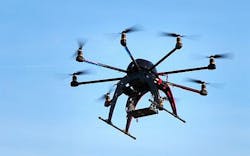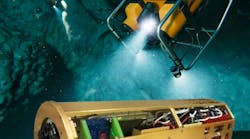Officials of the U.S. Office of the Secretary of Defense (OSD) Rapid Reaction Technology Office in Falls Church, Va., have released a request for information (RRTO-2014-11-26-RFI-Spiral-15) for the Thunderstorm Technology Demonstration.
This initiative has two thrusts: demonstrating chemical and biological agent detection from UAVs; and countering commercially available UAVs carrying chemical and biological weapons payloads.
Related: FAA's impending rule on small UAVs may usher in a new era of civil aerial warfare
The first focus area explores the potential of using a battery-powered vertical take-off and land (VTOL) UAV to detect and identify chemical and biological weapons of mass destruction (WMD).
Capabilities of interest include a backpackable system deployed from humvee-sized vehicles; UAV payloads that remotely detect chemical and biological agents, and transmit data about these agents to users more than one kilometer away; ease of use; and ground stations with visual displays of the sensing data received from the mobile detection systems; autonomous operations; ability to operate as high as 1,000 feet above the ground; and UAVs that have modular payloads.
Chemical and biological payloads should be able to detect standard G, H and V series chemical vapors and liquids; precursors or degradation chemical and biological agents; and persistent and natural flora. Payloads also should be able to collect samples for identification.
Related: Small UAVs begin taking on role of electronic warfare aircraft
The second focus area will explore ways to counter a small, low-cost commercial off-the-shelf UAV carrying a chemical or biological weapon. Capabilities of interest rapid detection and identification of hostile chemical- and biological-carrying UAVs; electronic systems that can prevent hostile use of these kinds of UAVs; and ways to intercept and neutralize these kinds of UAVs.
OSD researchers particularly are interested in kinetic and non-kinetic counter-UAV technologies that can be used inside and outside of the continental U.S.
Technology demonstrations are for the Thunderstorm Technology Demonstration spiral 15-3, which will be in spring 2015 at Camp Shelby outside of Hattiesburg, Miss. Thunderstorm provides an opportunity for technology developers to demonstrate new and evolving technological capabilities.
Related: Electro-optical sensor payloads for small UAVs
Companies and colleges interested in submitting applications to participate in the Thunderstorm technology demonstration should email four-page capability white papers no later than 26 Nov. 2014 to [email protected]. Email questions and concerns to the same address.
More information is online at https://www.fbo.gov/spg/ODA/OSD/RRTO/RRTO-2014-11-26-RFI-Spiral-15/listing.html.



